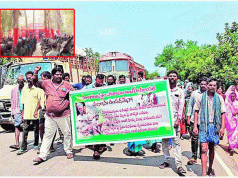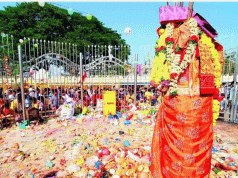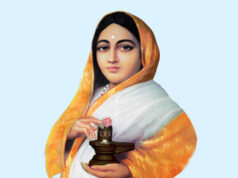 Veteran Sangh Pracharak Shri Dhanprakash is believed to be the oldest Pracharak in the RSS today. After becoming a swayamsevak in 1942 in Delhi and then fully dedicating himself to the cause of motherland as a Pracharak in 1943, he is witness to various developments in the rise of RSS during the last seven decades. He is now 100, and is still fit and active. His vigour and strong will power can be understood from the fact that he still drives motorcycle to meet the local workers, uses stairs not the lift to reach the fourth floor of the Jaipur Sangh Karyalaya, where he stays, washes his clothes himself, does not depend upon other karyakartas for anything and never misses the daily shakha. Organiser Sr Correspondent Pramod Kumar spoke to him in Jaipur on February 18 to know how he looks at the journey of Sangh in all these years. Excerpts:
Veteran Sangh Pracharak Shri Dhanprakash is believed to be the oldest Pracharak in the RSS today. After becoming a swayamsevak in 1942 in Delhi and then fully dedicating himself to the cause of motherland as a Pracharak in 1943, he is witness to various developments in the rise of RSS during the last seven decades. He is now 100, and is still fit and active. His vigour and strong will power can be understood from the fact that he still drives motorcycle to meet the local workers, uses stairs not the lift to reach the fourth floor of the Jaipur Sangh Karyalaya, where he stays, washes his clothes himself, does not depend upon other karyakartas for anything and never misses the daily shakha. Organiser Sr Correspondent Pramod Kumar spoke to him in Jaipur on February 18 to know how he looks at the journey of Sangh in all these years. Excerpts:
What is the secret of your perfect heath even at 100?
I even don’t know. It is because of God’s grace or may be because of my physical activeness. In the Sangh, one remains active for the cause of motherland till his last breath. I am also doing the same. Prior to joining the Sangh, I spent my childhood in an Akhara. In the shakha also I used to be among the few swayamsevaks who performed the largest number of ‘Dand Baithaks’ and ‘Dand Prahars’. I have the record of performing 700 ‘Dand Prahars’ in one go. That might have made my body fit.
Share something about your childhood with our readers.
I was born on January 10, 1918 at Mallapura Village under Muzaffarnagar District of Uttar Pradesh. But I studied in Kota, Rajasthan, where my father was an inspector in Cooperative Society. I stayed in a hostel of Kota for five years during my school days. I completed 12th from Herbert College of Kota. Then I got a government job in Delhi and shifted there in early 1940s.
How did you become a swayamsevak?
I became the Sangh swayamsevak in Delhi in the end of 1942. One of my colleagues introduced me to the shakha at Minto Road. Then in 1943, I became a Pracharak due to the motivation of the then senior Sangh Pracharak Shri Vasantrao Oak. Then main mode of local transport was a bicycle. In 1943, I paddled a cycle for about 120 miles to and fro from Delhi to the banks of the Ganga for an event.
How did you become a Sangh Pracharak?
While doing the job in Delhi, a clerk working with me expressed grave concern over the poor condition of the Hindus and narrated how they are being targeted everywhere in the country. I asked him what was the remedy? “Unity of Hindus,” he said. I asked him what has to be done for unity of the Hindus. He took me to a Sangh Shakha then conducted at Railway Quarters at Minto Road. The then senior Pracharak Shri Vasantrao Oak watched my activities at the Shakha and after sometime asked me whether I could do the Sangh work outside Delhi too. I agreed. He then sent me to Saharanpur. I went there even without tendering resignation from the job. I was there for six months. From there I was sent to Aligarh. We mobilised the local Hindus to curb the activities of fanatics. That unity put a check on the riots that had become everyday affair in those days.
How do you look at your seven decades of Sangh work?
It is growing and getting stronger. I could not see RSS founder Dr Keshavrao Baliram Hedgewar, but knew the second Sarsanghachalak Shri Guruji closely. He was a spiritually enlightened personality. His will power was unexceptional. Once he went to Hoshiyarpur, Punjab. The road was blocked due to heavy rains. We had to cross a railway line through a small bridge. But the major portion of the bridge had been washed away in the rains. Shri Guruij hurriedly left the car and crossed that bridge over the railway track. He did it so quickly that the swayamsevaks accompanying him could not do anything except catching him. They were really concerned as it was highly dangerous to cross the bridge in that condition. But Guruji did that as he had to reach Ludhiana timely for a pre-scheduled meeting. His punctuality was admirable. I remember an incident of Rajasthan. We had gone to see off Shri Guruji at airport. I developed the feeling that Shri Guruji did not reply my Namaskars offered several times. But when the bell for sitting in the plane rang, Shri Guruji stood and first offered Namaskar to me. I cursed myself as to why such a narrow feeling developed in my mind. Shri Guruji was very particular about attending a daily shakha. I never saw him reaching late at any function.
There is one more incident about Shri Guruji. A swayamsevak of Jodhpur had a furuncle in his body and that was not healing. He was also among the group of swayamsevaks who reached the airport to see off Guruji. Guruji enquired about his wound. He said that it was not healing. Guruji asked him to belive in himself and the Almighty. After sometime that swayamsevak got well. Unfortunately, Shri Guruji detected with cancer after few days.
What about the other Sarsanghachalaks?
Every Sarsanghachalak has contributed in the Sangh growth in his own way. When one used to meet Rajju Bhaiya, one had the feeling that he is my own family member. He always behaved like an ordinary person. The Sangh work has expanded manifold during all these years. But we have still miles to go. We have activities in many segments of the national life, but still we have to work at different fronts. The society is gradually getting awakened, but we have to achieve much more. I feel the year 2021 will dawn with a brighter picture of Bharat. The major problem with our society today is that it is divided into many factions. Caste differences are weakening it. Curbing these differences should be the foremost task of everyone. The life sketches of Shri Guruji and Dr Hedgewar should be repeatedly read by all the swayamsevaks in the shakhas. What we want to convey to others should first reflect in our own conduct.
At how many places have you worked as a Pracharak?
After Aligarh, I was sent to Ambala as Zilla Pracharak, where Shri Sohan Singhji was the Tehsil Pracharak. After Ambala, I went to Rohtak. I was in jail for sometime after the first ban on RSS. After the release, I went to Shimla. Then I went to Jammu. Then I was shifted to the Vidyarthi Kshetra. I was in Bharatiya Mazdoor Sangh (BMS) from 1976 to 1996. I worked with Sewa Bharati also for some time. In 1976, I declared at a meeting of labourers that ‘whatever I say is truth, no lie’. Since then I keep those words in my mind whenever I speak to anyone. I never tell a lie.
What difference do you find in the Sangh work in 1940s and 2017?
In 1940, the work was very difficult. There was shortage of resources. The country was passing through a transition phase following the demand for Partition. The agitation against British was getting stronger, but the Muslims were causing unrest in the country. Then the country was Partitioned. Hence, apart from expanding the Sangh work, looking after the migrants coming from Pakistan was the immediate task. I worked on a cycle for many years. I got a moped first time when I was shifted to BMS. When I reached Jaipur, a karyakarta provided me his scooter, which I used for many years. The main difference then and now is that the work has now expanded manifold and there is no shortage of resources. The work is getting stronger day-by-day and I hope our target of ‘Param Vaibhav’ is not too far. Bharatmata will regain her pristine glory shortly.
What needs to be done to strengthen the social harmony?
It is the most important task. But what is done is lost during the elections as most political parties and voters think and act on caste lines only. That mindset has to be changed. Efforts should continue to bring all sections together.
What advice would you like to give to the young swayamsevaks?
The system of man-to-man contact is time tested. The technology might have reduced distance, but the habit of personal contact should not be compromised. It connects the hearts. Also, every karyakarta should show through his conduct what he expects from others.
Courtesy: Organiser














